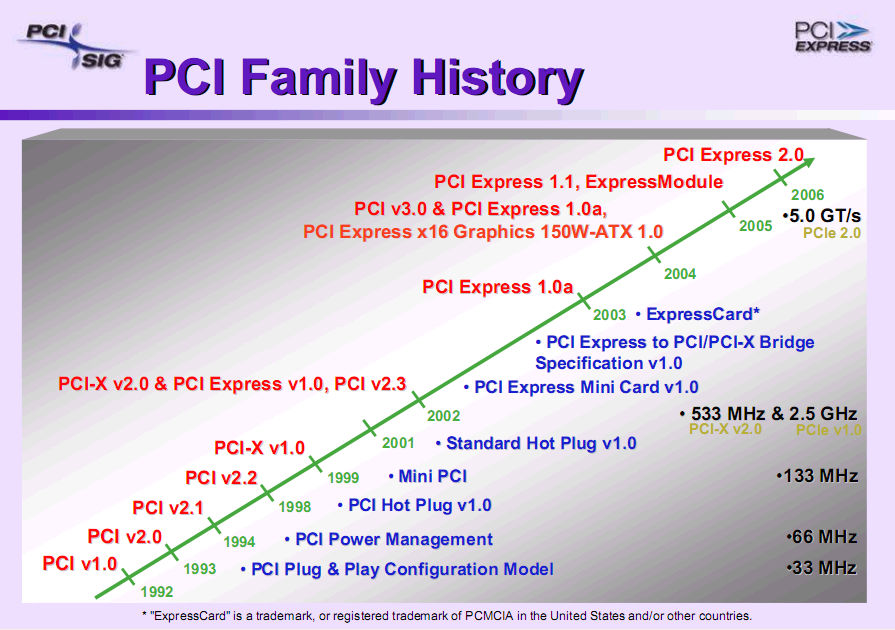PCI Express 3.0: On Motherboards By This Time Next Year?
After an unfortunate series of untimely delays, the folks behind PCI Express 3.0 believe they've worked out the kinks that have kept next-generation connectivity from achieving backwards compatibility with PCIe 2.0. We take a look at the tech to come.
PCI Express 3.0: An Update
Moore's Law states that the amount of transistors which can be placed on a chip will double every two years. This has often been misinterpreted as a statement that processor speed will double every two years. It’s a misinterpretation that the computer-buying general public has turned into an expectation of exponentially-scaling PC performance.
However, as you’ve undoubtedly noticed, shipping processors have been stuck between 3 GHz and 4 GHz for about six years now. So, the computer industry has had to find other ways to make data move faster. One of the most important of those ways has been maintaining balance between platform components using PCI Express, the open standard technology that enables high-speed graphics cards, expansion cards, and other onboard computer components. It’s at least arguable that PCI Express is as important to scalable performance as multi-core processors. Although dual-core, quad-core, and hexa-core CPUs can only be adequately used by applications optimized for threading, every program installed on your machine can and will touch components attached via PCI Express in some way.
Many industry observers originally expected motherboards and chipsets based on next-generation PCI Express 3.0 to appear in the first quarter of 2010. Unfortunately, problems with backward compatibility delayed the launch of PCI Express 3.0, and as we enter the second half of this year, we’ve been left waiting for official word on the new standard's release.
Finally, following a conference call with PCI-SIG (the Special Interest Group that oversees the PCI and PCI Express standards), we at last have some answers.
Get Tom's Hardware's best news and in-depth reviews, straight to your inbox.
-
cmcghee358 Good article with some nice teases. Seems us regular users of high end machines won't see a worth until 2012. Just in time for my next build!Reply -
tony singh What the..... pcie3 already devoloped & most games graphics are still of geforce 7 level thnk u consoles..Reply -
iqvl Good news to peoples like me who haven't spent any money on PCIE 2.0 DX11 card due to nVidia's delay in shipping GTX460.Reply
Can't wait to see PCIE 3.0, native USB3/SATA3, DDR4, quad channel and faster&cheaper SSD next year.
In addition, I hate unreasonably priced buggy HDMI and would also like to see the Ethernet cable(cheap, fast and exceptional) based monitors as soon as possible.
http://www.tomshardware.com/news/ethernet-cable-hdmi-displayport-hdbaset,10784.html
One more tech that I can't wait to see: http://www.tomshardware.com/news/silicon-photonics-laser-light-beams,10961.html
WOW, so much new techs to be expected next year! -
ytoledano Processor speed *is* increasing exponentially! Even a 5% year-on-year increase is exponential.Reply -
Casper42 I havent read this entire article but on a related note I was told that within the Sandy Bridge family, at least on the server side, the higher end products will get PCIe 3.0.Reply
And if you think the Core i3/5/7 desktop naming is confusing now, wait till Intel starts releasing all their Sandy Bridge Server chips. Its going to be even worse I think.
And while we're talking about futures, 32GB DIMMs will be out for the server market most likely before the end of this year. If 3D Stacking and Load Reducing DIMMs remain on track, we could see 128GB on a single DIMM around 2013, which is when DDR4 is slated to come out as well. -
JonnyDough ReplyAfter an unfortunate series of untimely delays, the folks behind PCI Express 3.0 believe they've worked out the kinks that have kept next-generation connectivity from achieving backwards compatibility with PCIe 2.0. We take a look at the tech to come.
It's nice to see the backwards compatibility and cost be key factors in the decision making. Especially considering that devices won't be able to saturate it for many years to come. -
rohitbaran ReplyNothing in the world of graphics is getting smaller. Displays are getting larger, high definition is replacing standard definition, the textures used in games are becoming even more detailed and intricate.
Even the graphics cards are getting bigger! :lol: -
iqvl rohitbaranEven the graphics cards are getting bigger!I believe that he meant gfx size per performance. :)Reply -
Tamz_msc ReplyWe do not feel that the need exists today for the latest and greatest graphics cards to sport 16-lane PCI Express 3.0 interfaces.
Glad you said today, since when Crysis 3 comes along its all back to the drawing board, again.
